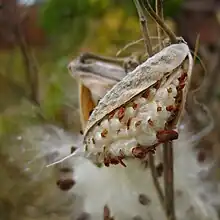regmacarp
English
WOTD – 24 May 2021
Etymology

The fruit of the common milkweed (Asclepias syriaca) is a regmacarp; when mature, it dehisces or splits open to release its seeds.
From Ancient Greek ῥῆγμα (rhêgma, “something broken or rent asunder; a breach, cleft, fracture”) (possibly ultimately from Proto-Indo-European *bʰreg- (“to break”)) + English -carp (suffix meaning ‘part of a fruit or fruiting body’) (ultimately from Proto-Indo-European *kerp- (“to harvest; to pluck”)), modelled after schizocarp. The word was probably coined by the Scottish physician and botanist William Ramsay McNab (1844–1889): see the 1871 article from the journal Nature quoted below.
Pronunciation
- (Received Pronunciation) IPA(key): /ˈɹɛɡməkɑːp/
Audio (Southern England) (file) - (General American) IPA(key): /ˈɹɛɡməkɑɹp/
- Hyphenation: reg‧ma‧carp
Noun
regmacarp (plural regmacarps)
- (botany, obsolete, rare) A fruit which, when mature, splits open to release its seeds; a dehiscent fruit. [from 1871]
- 1871 October 12, W[illiam] R[amsay] McNab, “Remarks on the Classification of Fruits”, in Nature: A Weekly Illustrated Journal of Science, volume IV, London, New York, N.Y.: Macmillan and Co., →OCLC, page 475, column 2:
- Taking the word Schizocarp as a type, I venture to suggest the term Achænocarp for the group of Achænes as used by Dr. [Alexander] Dickson, thus avoiding all confusion, and allowing the term Achæne to remain in its restricted sense. Regmacarp I would apply to the group of capsules, using the term capsule for one division of the group. […] The derivation of these terms at once explains their application. […] Regmacarp from regma, a rupture, in allusion to the dehiscence. […] In using these terms I would employ them in the following manner:— […] II. Dry Dehiscent Fruits. 3. Regmacarps. A. Follicle. Simple, dehisces by one suture. […]
- 1874, Robert Brown, “The Fruit”, in A Manual of Botany: Anatomical and Physiological: For the Use of Students, Edinburgh, London: William Blackwood and Sons, →OCLC, pages 482–483:
- The truth is, that it is impossible to find a classification of fruits which is founded on strictly scientific principles—the forms merging into each other; […] Accordingly, in the following classification, in which we have mainly followed Dr [Maxwell Tylden] Masters, all the less easily defined forms are omitted, and the list reduced as much as possible, without at all destroying its usefulness. […] monothalmic fruits. A. Ripe pericarp uniform. […] Fruits dehiscent.—II. Pods, or Regmacarps—viz., Follicle, Legume, Siliqua, Capsule, Pyxis.
- 1879, Asa Gray, “The Fruit”, in The Botanical Text-book. Part I. Structural Botany or Organography on the Basis of Morphology. […], 6th edition, London: Macmillan and Company, →OCLC, section II (The Kinds of Fruit), paragraph 555, footnote 1, page 292:
- Dr. Master's [i.e., Maxwell T. Masters'] modification of [Alexander] Dickson's and [William Ramsay] McNab's classification of simple fruits, as to primary kinds, is into 1. Nuts, or Achænocarps, dry and indehiscent; 2. Pods, or Regmacarps, dry, dehiscent; 3. Stone-fruits, or Pyrenocarps, fleshy without, indurated within, indehiscent; 4. Berries, or Sarcocarps, fleshy throughout, indehiscent.
Related terms
Translations
dehiscent fruit
Further reading
 dehiscence (botany) on Wikipedia.Wikipedia
dehiscence (botany) on Wikipedia.Wikipedia
This article is issued from Wiktionary. The text is licensed under Creative Commons - Attribution - Sharealike. Additional terms may apply for the media files.